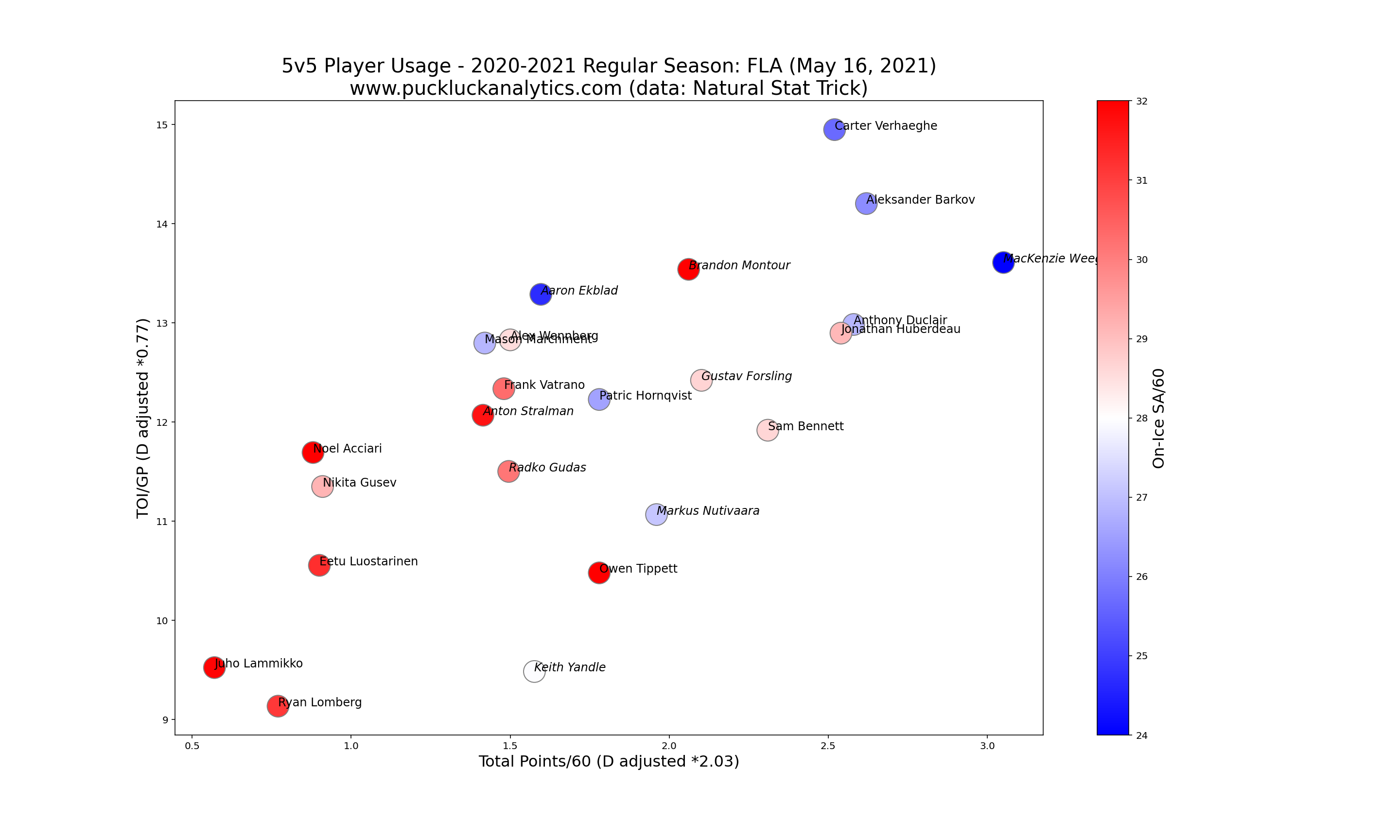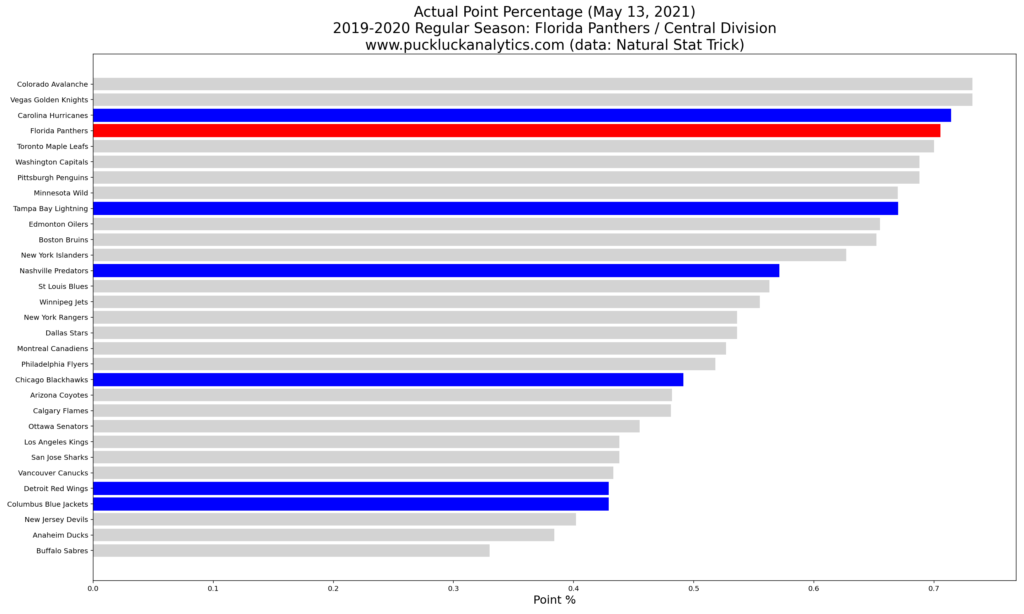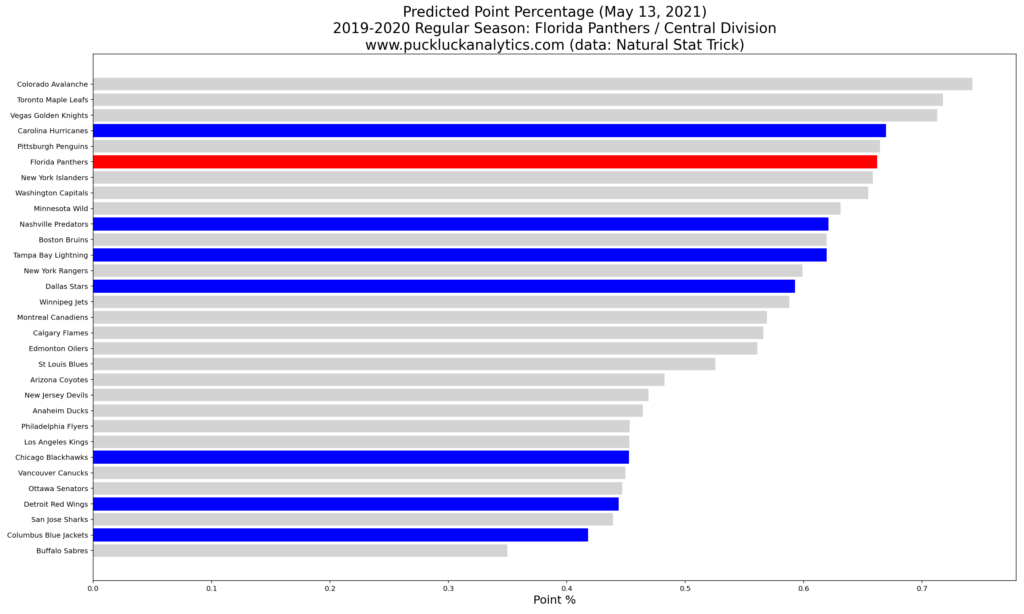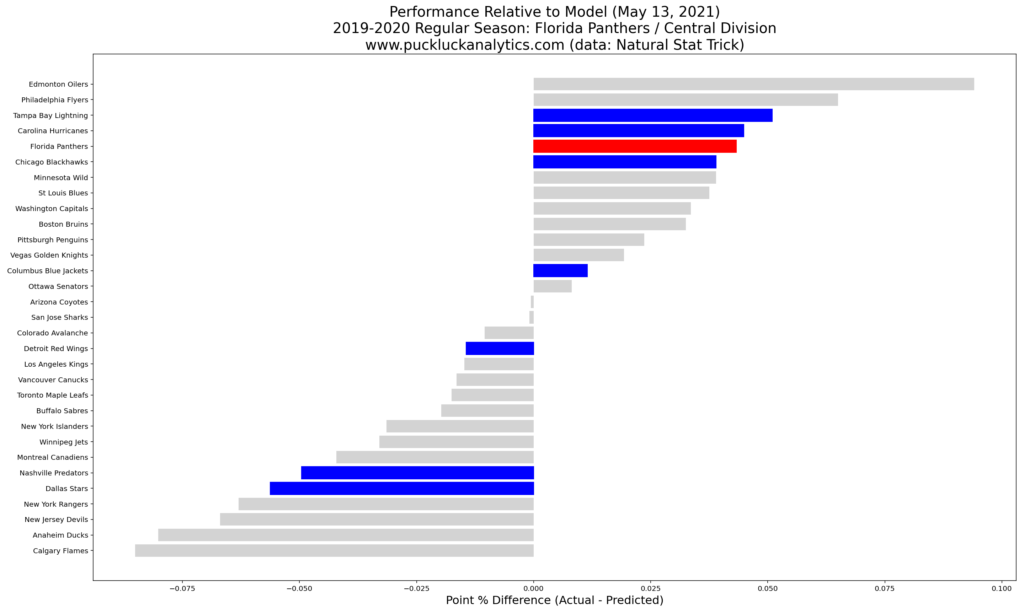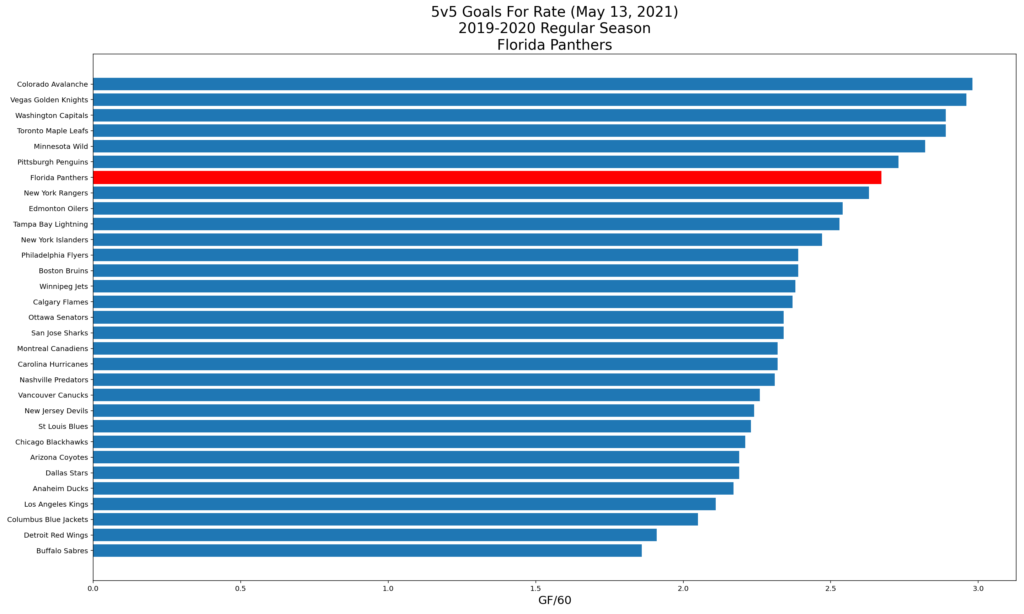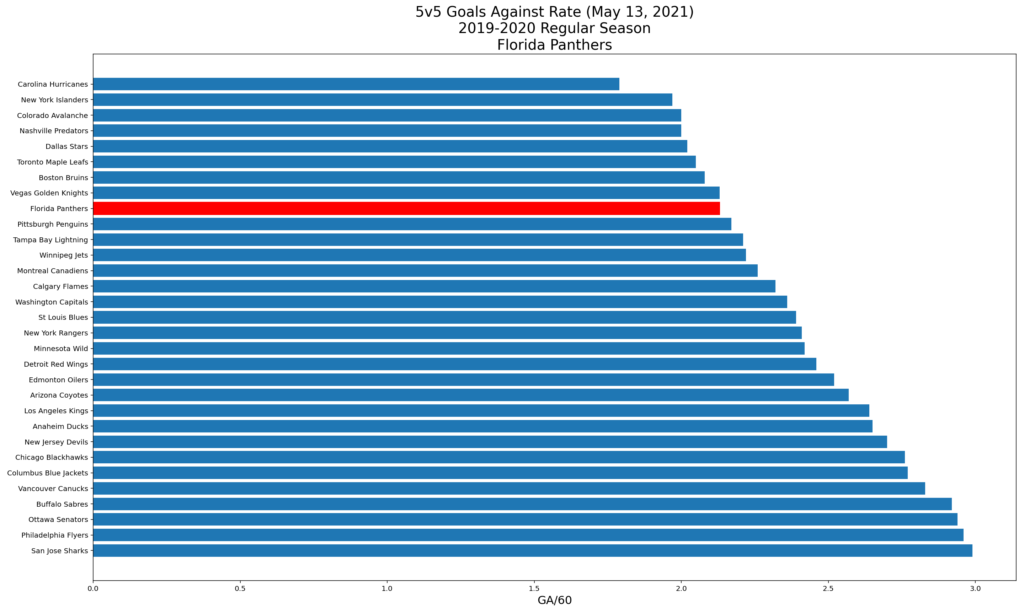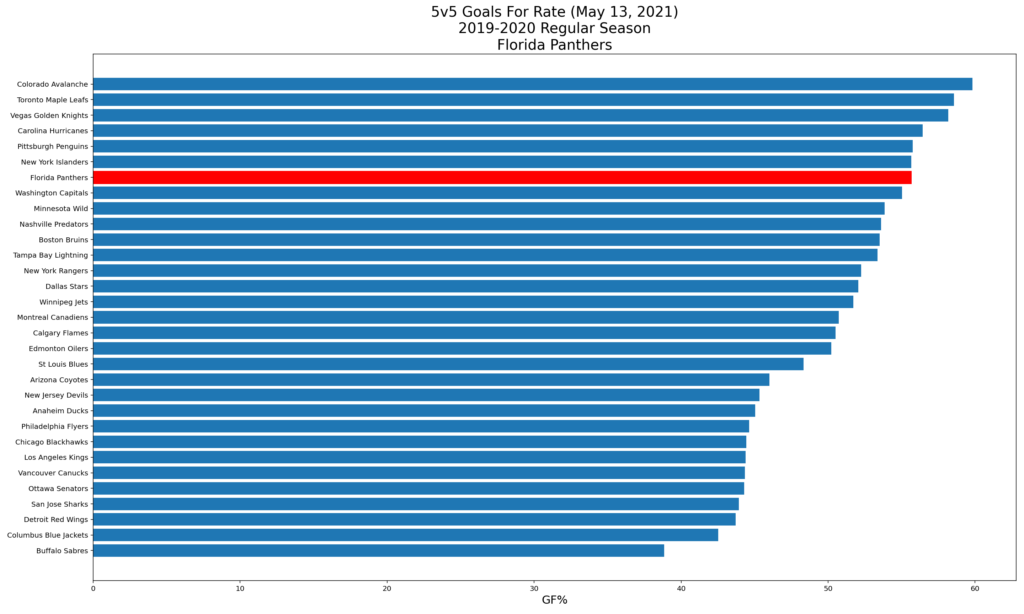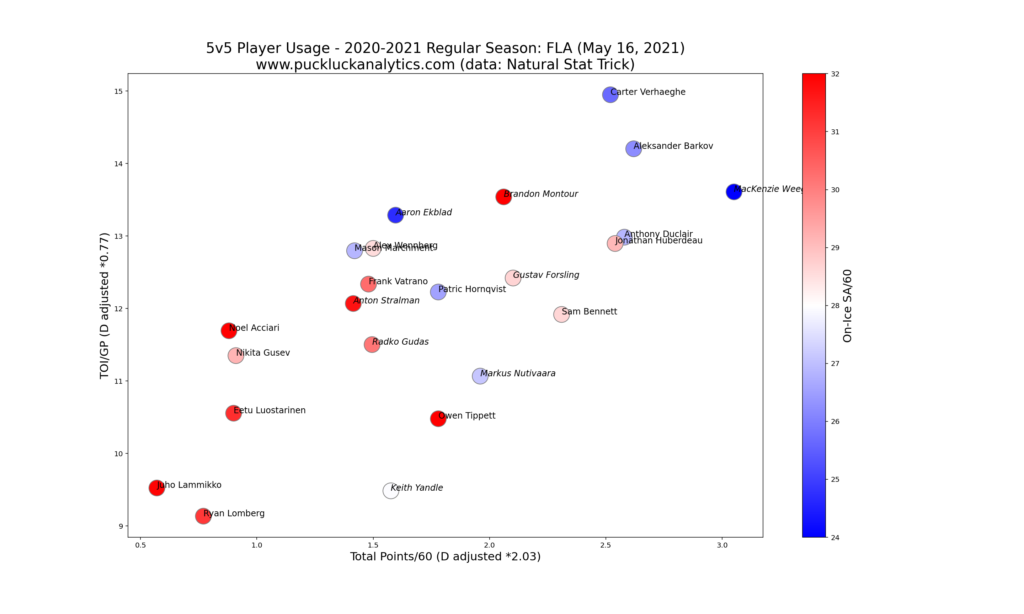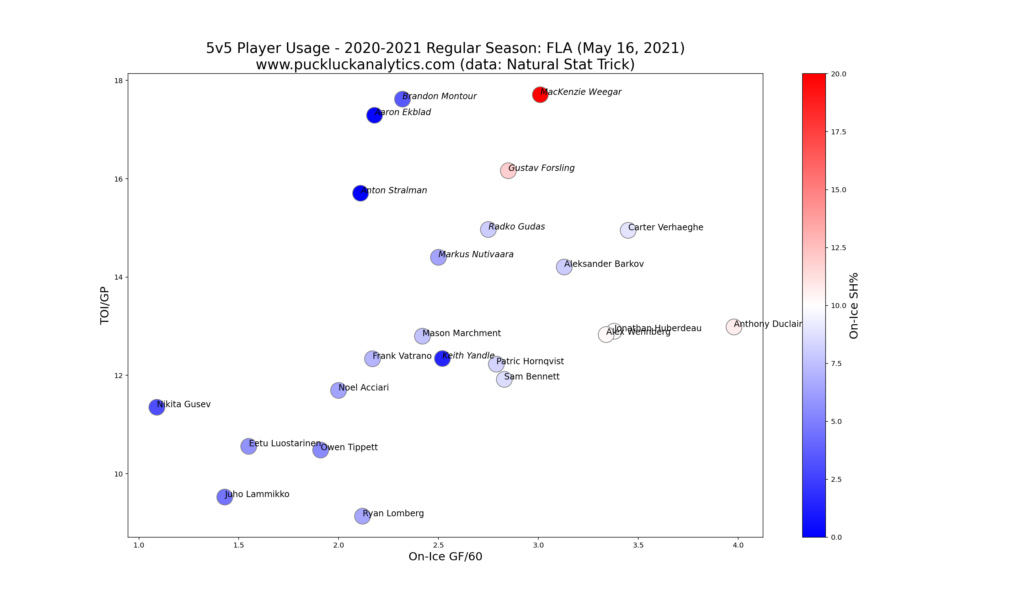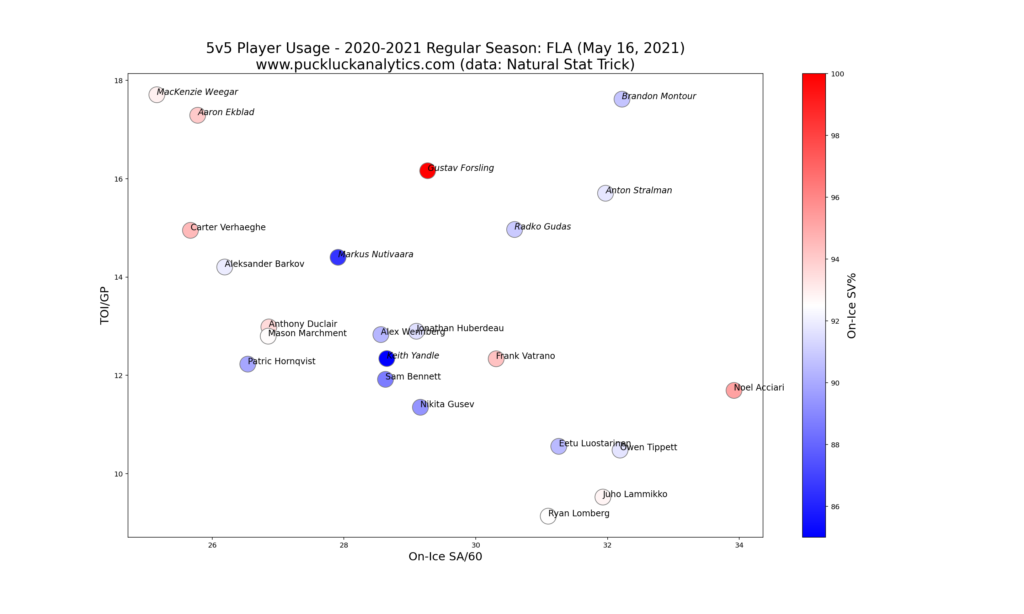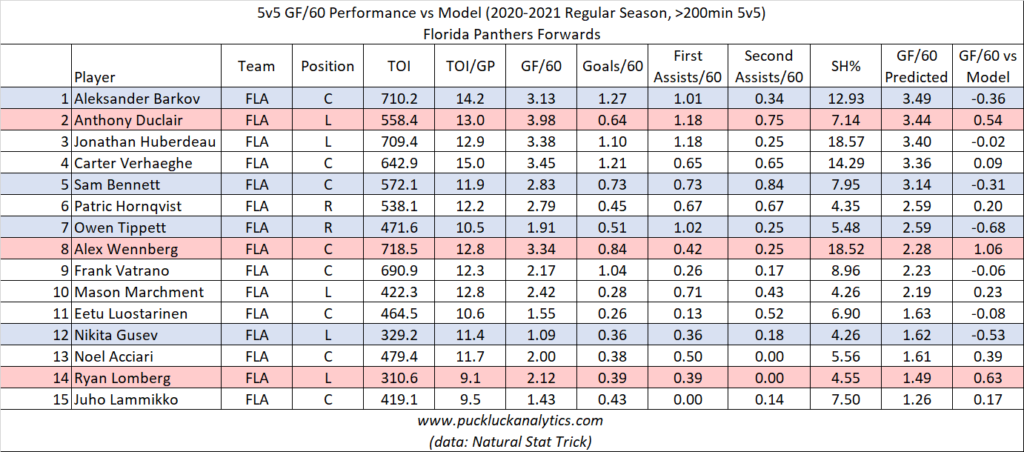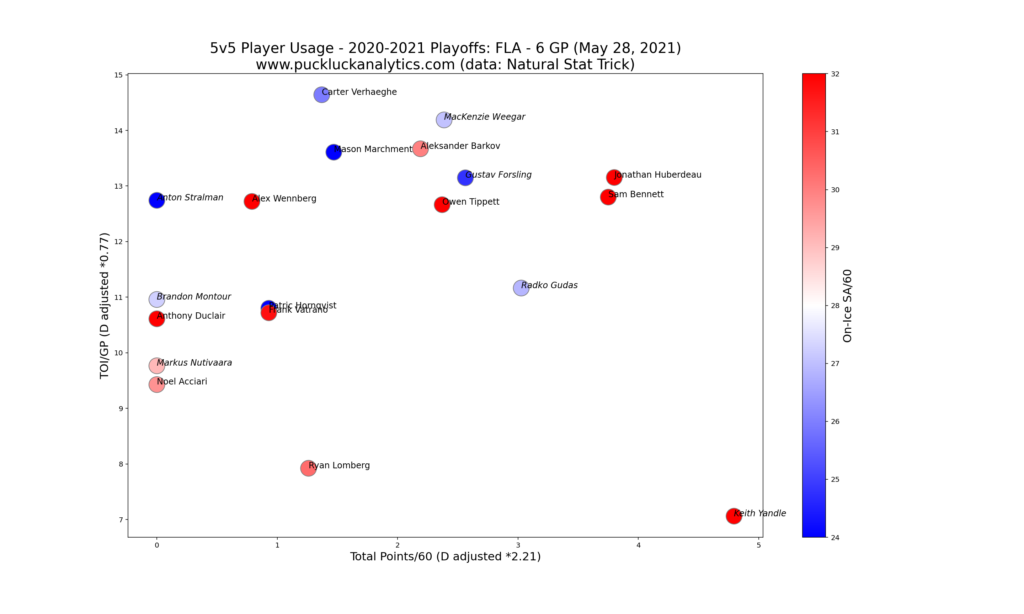The Florida Panthers resurgence this season was one of the good news stories around the NHL. The Panthers were fun to watch and duked it out with the top teams in the Central Division all season. Let’s dig into the Panthers season and see what went right in Florida this year. For more detail on the plots we’ll be looking at, I encourage you to check out this post.
Overall Performance (Regular Season)
The Panthers hung with the heavyweights in the Central Division all season, finishing second in a tight race among the top three teams in the division. Let’s take a look at how their 5v5 play stacks up using our points predictor model to look for signs of whether their results were backed by strong 5v5 play.
We see that the Panthers outperformed our points predictor model, suggesting that their results did benefit from some impacts outside of their 5v5 play. Special teams and overtime results are the usual suspects for these variances. Yet the Hurricanes and Lightning outperformed the model by almost identical margins so the model still projected the Panthers to finish in second in the division.
Let’s also look at the 5v5 goal rates the points predictor model uses as input.
The Panthers were strong on both sides of the puck at 5v5 this season, resulting in strong a strong goal differential. Overall, they look like a balanced team that should look for incremental improvements wherever they can find good value this offseason.
Player Performance (Regular Season)
We’ll look at a 5v5 player usage chart to get a visual representation of the Panthers depth chart. By factoring defensemen’s stats, we can compare them directly with forwards. The top players should at the top right of this chart and we should see the rest of the players distributed along a diagonal line toward the bottom left.
We see Alexander Barkov, Carter Verhaeghe, and MacKenzie Weegar at the top of the chart as players who led the Panthers through the regular season. Generally, the rest of the players are along the diagonal suggesting that player usage was relatively optimal.
By plotting on-ice GF/60 vs TOI/GP, we get a visual representation of relative offensive impacts. Players located further to the top right on this plot provided larger contributions to team GF/60.
Again, there really aren’t any surprises on this plot. The Panthers best players produced as their best players this season and the depth players appear to have been utilized effectively, providing solid secondary offense.
With on-ice SA/60 vs TOI/GP, we get a similar visual for relative defensive impacts to team GA/60. This time, better impacts are further left and down.
Many of the Panthers top offensive players appear at the left side of this plot, showing us they also had strong defensive impacts. Younger players, like Owen Tippett are further right, which is generally a sign of youth for developing players.
We’ll use our on-ice GF/60 models to evaluate the impact players had on their team mates. We’re interested in the variance between the model output and actual on-ice GF/60. Negative variances suggest that a player had a positive impact on his line mates and we are looking for variances greater than about 0.3.
There are quite a few standouts among the Panthers forwards looking at their impact on line mates. Barkov is an elite player and it’s not a surprise to see him having a positive impact. Others with negative variances may be more notable. Sam Bennett broke out offensively after arriving from Calgary at the trade deadline. However, after being mostly utilized in a bottom six role for the Flames, the results we see here are more likely a result of his usage there. His spot on the second line in Florida was likely a more suitable role for him. Tippett and Nikita Gusev also look like they had a strong impact on their line mates and could be poised for breakouts next season given larger roles.
Meanwhile, Anthony Duclair, Alex Wennberg and Ryan Lomberg all have large positive variances that suggest they were carried by their line mates. In Duclair’s case, he may be better suited to a second line role if the Panthers can find an upgrade for the top line. Wennberg’s results are the most concerning. With his shooting percentage through the stratosphere this year, the model output is somewhat inflated and the gap between the model and actual may be even larger than shown in the chart. Wennberg looks like a prime candidate for regression next season.
Among the Panthers defensemen, we see model results that align fairly well with the actual numbers. This suggests that the Panthers defensemen generally pulled their weight offensively. Radko Gudas is the only player who exceeds our threshold for variance that suggest he may have been a drag on the offense.
The Panthers goaltending was relatively strong overall this season. While Sergei Bobrovsky’s numbers were a bit lower than ideal for a starter, they weren’t abysmal. Chris Driedger put up excellent numbers in a backup role. Spencer Knight made his NHL debut late in the season and had a strong showing through 4 games.
Playoff Performance
While a single round of the playoffs is much too small a sample to make any long term projections from, looking at the Panthers series against the Lightning can give us some insight into what happened in the playoffs.
The Panthers usage chart looks somewhat similar to the regular season for their 6 playoff games, showing us that their best players produced at playoff time. Goaltending may have made the difference, as Andrei Vasilevski was strong at the other end, while the Panthers used multiple goaltenders trying to find an edge. The Panthers put in a good effort against a strong team and came out on the losing end this time.
Looking Ahead
Things look bright in Sunrise after a strong season. However, with nearly $72M already committed to next season’s salary cap, the Panthers will have to be prudent while trying to improve their roster this offseason.
Key RFAs:
Anthony Duclair and Sam Bennett are the most notable RFAs on the Panthers’ roster. We saw signs that Duclair was carried by his line mates this season and the Panthers should be cautious that they don’t overpay him. Likewise, Bennett seemed to fit in well upon arriving in Florida, with an offensive outburst following the trade. He look like a good fit on the second line but the Panthers shouldn’t put too much focus on his small sample of work after the trade deadline when working out a deal.
Key UFAs:
Alex Wennberg and Nikita Gusev are key UFAs for the Panthers. We saw serious concerns around Wennberg in our review suggesting he is likely to regress next season. The Panthers are probably best off to let him walk and look to other players to fill the hole. They may even have options already in the organization, such as Owen Tippett, who we saw looks ready for an opportunity with a larger role. Gusev, on the other hand, showed signs of a potential breakout and the Panthers should definitely consider the possibility of bringing him back next season.
Key Players Under Contract:
Barkov and Verhaeghe drove the Panthers’ offense this season and MacKenizie Weegar had a breakout season on defense. With a combined cap hit of only $10.15M next season for the Panthers’ top three players, continued strong play from these stars would be a fantastic base to build a contender around.
Tough Questions:
Can the Panthers clear some cap space to make room for a few roster upgrades before the 2021-2022 season starts? Sergei Bobrovsky is signed for another five seasons at a $10M cap hit. The Panthers need him to be better than he was this season or they need to get out from under his cap hit. Keith Yandle at $6.35M and Anton Stralman at $5.5M are also chewing up a lot of cap space. If the Panthers can clear some of this cap space and they use the space to bring in better players, they have a good shot at taking another leap forward next season.
Offseason Priority:
The Panthers are benefitting from strong production from players on high value contracts, not unlike the Colorado Avalanche. If they can surround these players with quality depth pieces in the middle of the lineup, they could be a force over the next couple of years. The Panthers should look to offload some high cost, low value contracts to teams with a lot of cap space and target high value middle six forwards and mid-pairing defensemen to improve their depth.
Check out my other season reviews, such as the Pittsburgh Penguins and the Edmonton Oilers, and subscribe to catch the rest of my season reviews as they come out.
data: Natural Stat Trick
cap data: CapFriendly
